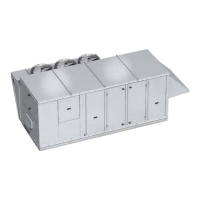Dedicated Outdoor Air Unit 23
Pre-Start-Up Checklist
o Remove any foreign objects that are located in the
unit.
o Check all fasteners, set-screws, and locking collars
on the fans, bearings, drives, motor bases and
accessories for tightness.
o Rotate the fan wheels and energy recovery wheels
by hand and ensure no parts are rubbing.
o Verify diameter seal settings on the energy recovery
wheel.
o Filters can load up with dirt during building
construction. Replace any dirty pleated filters and
clean the aluminum mesh filters in the intake hood.
o Verify that non-motorized dampers open and close
properly.
o Check the tightness of all factory wiring
connections.
o Verify proper drain trap installation.
o Check condensing fans for any damage or
misalignment. Spin the blades and make sure they
don’t contact any parts and are free turning without
any resistance.
o Look over the piping system.
o Inspect all coils within the unit. Fins may get
damaged in transit or during construction. Carefully
straighten fins with a fin comb.
Electrical
oDisconnect and lock-out all power switches.
o Verify control wire gauge.
o All field-mounted sensors and instruments are
installed and wired.
o Unit controls are off.
o Electrical service matches unit voltage.
o Electrical field wiring is complete.
o All electrical connections are tightened.
o Compressor and motor breakers or fuses are open
(disabled).
o Main power is wired to the disconnect.
o Discharge air sensor is installed per wiring
instructions.
o Space temperature and humidity sensors are
installed per if selected with unit.
Compressors
o This unit contains an external crankcase heater for
each standard or digital scroll compressor. The
variable speed compressor uses internal stator
heating. Each compressor needs power supplied to
it 24hours prior to start-up. If start-up is scheduled
in 24 hours, unlock the disconnect power and
energize unit.
oCompressor shipping brackets are removed if
provided.
SPECIAL TOOLS REQUIRED
• Voltage Meter (with wire probes)
• Amperage Meter
• Pressure Gauges – (refrigerant)
• Tachometer
• Thermometer
• Incline manometer or equivalent
Start-Up Procedure
The unit will be in operational mode during start-up. Use
necessary precautions to avoid injury. All data must be
collected while the unit is running.
o Make sure Pre-Start-Up checklist is complete.
o Jumper R to G, R to Y1, and R to Y2 (if applicable)
on the control board.
o Turn the disconnect on. After 3 minutes compressors
will come on. Make sure all fans and compressors
are rotating the correct direction.
o Allow the unit to run until the refrigerant system
stabilizes. Approximately 1-2 minutes.
Voltage Imbalance
In a 3-phase system, excessive voltage imbalance
between phases will cause motors to overheat and
eventually fail. Maximum allowable imbalance is 2%.
To determine voltage imbalance, use recorded voltage
measurements in this formula.
Key: V1, V2, V3 = line voltages as measured
VA (average) = (V1 + V2 + V3) / 3
VD = Line voltage (V1, V2 or V3) that
deviates farthest from average (VA)
Formula: % Voltage Imbalance = [100 x (VA-VD)] /VA
Start-Up Unit
IG Furnace
o If there is an indirect gas-fired furnace in this unit,
refer to the manual provided with this unit for Pre-
Start-Up information.
o Gas piping is complete and gas lines are purged.
o Gas venting is in place.
Hot Water/Chilled Water Coils
o Chilled water piping system is complete.
o Hot water piping system is complete.
o Control valves are installed, wired, and operating
properly.
o Water coils are balanced to design GPM.
o Water system is free of air.

